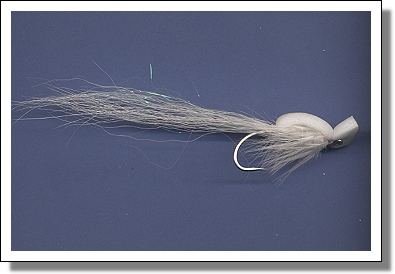
The Gartside Gurgler may well be the most popular and successful surface fly designed in recent years, used by anglers all over the world to land a wide variety of sport fish. As with many popular patterns, flytyer's often make their own adaptations to original patterns and variations abound. But this is the ORIGINAL Gartside Gurgler, as I first tied it more than twenty years ago.
The Gurgler can be tied in both large and small sizes and on either fresh water or salt water hooks and in a variety of colors to suit conditions or simply the tyer's whims. In addition to the white Gurgler described below, I also tie some of my Gurglers in yellow and in black. I don't believe the fish pay much attention to the different colors, but I find that under certain light conditions it's easier for me to see yellow or black and this often makes a big difference when I'm tracking the fly.
Tying the Gurgler
|
Hook: |
Mustad #34011 or 34007 (SW), sizes 4-2/0 |
|
Thread: |
Danville's 3/0 or Monocord, white |
|
Tail: |
Very sparse bucktail or marabou plumes overlaid with five or six strands of pearl Glimmer or Krystal Flash |
|
Body: |
White closed-cell foam, with five evenly-spaced segments. Foam should be 1/2"-5/8" wide for most flies. Use foam at least 1/8" thick. |
|
Rib: |
White or Grizzly saddle hackle palmered between segments |
|
Carapace or Shell: |
Closed-cell foam pulled over body and secured just behind eye.Trim foam leaving an excess of about 1/2" protruding beyond eye. |
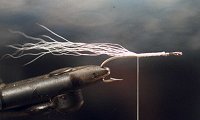 Attach thread just behind eye and wind back approx. halfway along shank. At mid-shank tie in a very sparse tail of bucktail or full tail of marabou plumes (tail should be approx. 1 1/2 times shank length). Leave rear half of shank bare.
Attach thread just behind eye and wind back approx. halfway along shank. At mid-shank tie in a very sparse tail of bucktail or full tail of marabou plumes (tail should be approx. 1 1/2 times shank length). Leave rear half of shank bare.
Tie in 6" of five or six strands of Glimmer at base of tail (tie them down in the middle of your strands, so that you have 3" forward of your thread wraps and 3" behind). Now bring the forward strands back over the tail and take a turn or two of thread to secure the strands and keep them out of your way).
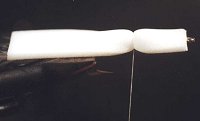 Cut 4"-5" of foam (approx. 3/4" wide for most sizes) and lay this flat on top of shank. (Remember that body and shell are formed from ONE piece of foam.) Tie in so that front part of foam ends just short of eye, leaving around 2"-3" trailing to the rear of the shank.
Cut 4"-5" of foam (approx. 3/4" wide for most sizes) and lay this flat on top of shank. (Remember that body and shell are formed from ONE piece of foam.) Tie in so that front part of foam ends just short of eye, leaving around 2"-3" trailing to the rear of the shank.
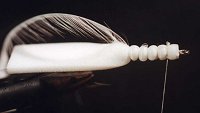 With your tying thread, make five distinct and evenly-spaced segments, cupping the foam around the hook shank as you wind thread forward.When segments are formed, wind thread to the rear in between segments, tightening thread as you do so.
With your tying thread, make five distinct and evenly-spaced segments, cupping the foam around the hook shank as you wind thread forward.When segments are formed, wind thread to the rear in between segments, tightening thread as you do so.
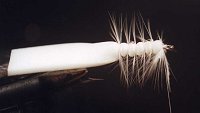 At beginning of rearmost segment, tie in saddle feather (with one side of hackle stripped) by the tip. Move thread forward again between segments up to the eye of the hook. Palmer feather forward between segments and tie down just behind eye. Trim excess.
At beginning of rearmost segment, tie in saddle feather (with one side of hackle stripped) by the tip. Move thread forward again between segments up to the eye of the hook. Palmer feather forward between segments and tie down just behind eye. Trim excess.
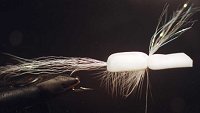 Bring foam over top of body and tie down snugly just behind eye. Bring five or six strands of Glimmer over the shell, snug them down and tie down at foam tie-down point. Trim away excess Glimmer. Whip finish head and trim lip to desired height.
Bring foam over top of body and tie down snugly just behind eye. Bring five or six strands of Glimmer over the shell, snug them down and tie down at foam tie-down point. Trim away excess Glimmer. Whip finish head and trim lip to desired height.
You can trim your lip in various ways, using a simple straight cut (the most usual way) or you may round the corners a bit to further cut down wind resistance and make the fly less likely to spin as it travels through the air.






